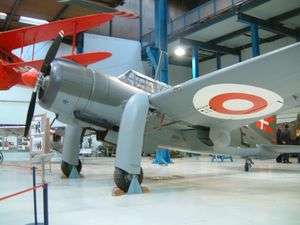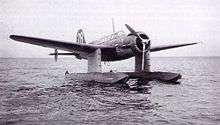Saab 17
| B 17 | |
|---|---|
 | |
| Saab B 17A. | |
| Role | Bomber, reconnaissance |
| Manufacturer | Saab |
| First flight | 18 May 1940 |
| Introduction | 1942 |
| Retired | 1955, Sweden 1968, Ethiopia |
| Status | Retired |
| Primary users | Swedish Air Force Ethiopian Air Force Finnish Air Force Austrian Air Force |
| Produced | 1941–44 |
| Number built | 323 |
The Saab 17 was a Swedish bomber-reconnaissance aircraft.
Development and service
The project was initiated in response to a request in 1938 from the Swedish air force for a reconnaissance aircraft that could replace the Fokker S 6. Design work began at the end of the 1930s as the L 10 by ASJA, but after the merger with Saab in 1939 it was renamed Saab 17. The wings were reinforced to make it possible for use as a dive bomber. Since there was a shortage of engines the aircraft were flown to their destination, where the engines were removed and returned for use by the next delivery. The aircraft was also made in three versions with different engines.
Two prototype L-10 aircraft were ordered, the first being powered by a 880 hp (660 kW) Nohab-built Bristol Mercury XII and the second by a 1,065 hp (794 kW) Pratt & Whitney R-1830 Twin Wasp.
The production B 17A used a Swedish-built Pratt & Whitney Twin Wasp, the B 17B a Svenska Flygmotor AB (SFA)-built Bristol Mercury XXIV, and the B 17C a Piaggio P.XI.[1] The aircraft could be fitted with wheels, skis or floats. A unique feature of the Saab 17 was its use of the extended landing gear assembly, with its large covers, as dive brakes.
Operational history
The first test flight was on 18 May 1940 and first deliveries to the Flygvapnet (Swedish Air Force) were in 1942. However, the development of the turbojet meant it had a short service history, but when the B 17 ended Swedish service in 1947–50, 46 were sold to Ethiopia, remaining in service until 1968. Two B 17As were sold to Finland in 1959 and 1960, serving as target tugs for the Finnish Air Force, both succumbing to accidents fairly quickly. For some months from very early 1945 fifteen B 17As were issued to DANFORCE (Danish Brigade of 5000 men in Sweden). However, as things unfolded with the German surrender, there was no need for them in the liberation of Denmark, and the aircraft were returned to the Flygvapnet a couple of months after the surrender.
Variants
- B 17A – Bomber version with 1,050–1,200 hp (780–890 kW) Pratt & Whitney R-1830-S1C3G Twin Wasp engine; production: 132
- B 17B – Bomber version with 980 hp (730 kW) Svenska Flygmotor Aktiebolaget (SFA)-built Bristol Mercury XXIV engine; production: 55
- S 17BL – Reconnaissance version with landing gear; production: 21
- S 17BS – Reconnaissance version with floats; production: 38
- B 17C – Bomber version with 1,040 hp (780 kW) Piaggio P.XIbis R.C.40D engine; production: 77
The SAAB 17 had a total production run of 323 aircraft.
Operators


Survivors
Five SAAB 17s are known to be in existence today. The Swedish Air Force Museum in Linköping has two aircraft in their collection, one S 17BL and one B 17A, the latter being kept in airworthy condition. Another B 17A is on display at the Danish Museum of Science and Technology in Helsingør. Two former Ethiopian B 17As were recovered in the 1990s and purchased by a South African collector. These are last known to have been relocated to Lithuania but their current status is not clear.[2]
_17005_5_(8289315680).jpg)
Specifications (B 17C)
Data from Saab Aircraft since 1937[3]
General characteristics
- Crew: two
- Length: 10 m (32 ft 10 in)
- Wingspan: 13.7 m (44 ft 11 in)
- Height: 4.5 m (14 ft 9 in)
- Wing area: 28.5 m2 (307 sq ft)
- Empty weight: 2,680 kg (5,908 lb)
- Gross weight: 3,870 kg (8,532 lb)
- Powerplant: 1 × Piaggio P.XIbis R.C.40D 9 cyl. air-cooled radial piston engine
- Propellers: 3-bladed Piaggio P.1001 variable pitch propeller
Performance
- Maximum speed: 435 km/h (270 mph; 235 kn)
- Cruise speed: 370 km/h (230 mph; 200 kn)
- Landing speed: 125 km/h (78 mph; 67 kn)
- Range: 1,700 km (1,056 mi; 918 nmi)
- Service ceiling: 9,800 m (32,200 ft)
- Rate of climb: 10 m/s (2,000 ft/min)
- Wing loading: 139 kg/m2 (28 lb/sq ft)
- Power/mass: 0.220 kW/kg 0.14 hp/lb
Armament
- Guns:
- 2× 8 mm (0.315 in) (Kulspruta) Ksp m/22F machine gun machine guns, fixed forward-firing
- 1× 8 mm (0.315 in) Ksp m/22R machine-gun flexibly mounted in the rear cockpit
- Bombs: 700 kg (1,500 lb) of bombs
See also
Aircraft of comparable role, configuration and era
- Aichi D3A
- Brewster SB2A Buccaneer
- Douglas SBD Dauntless
- Fairey Battle
- Ilyushin Il-2
- Junkers Ju 87
- Northrop A-17
- Sukhoi Su-2
Related lists
References
| Wikimedia Commons has media related to Saab 17. |
- ↑ "B 17 – Saab 17 (1941–1955)". Avrosys. pp. 1–5. Retrieved 3 September 2015.
- ↑ "Baltbound Bombers – 2". Lae – inte bara en stad på Nya Guinea (in Swedish). Retrieved 3 September 2015.
- ↑ Andersson, 1989, pages 59–65
Bibliography
- Andersson, Hans G. (1989). Saab Aircraft since 1937. Washington, D.C. / London: Smithsonian Institution Press / Putnam. pp. 59–65. ISBN 0-87474-314-1.
Further reading
- foreword by Bill Gunston, ed. (1989). Jane's Fighting Aircraft of World War II (2001 ed.). New York & London: Military Press & Crescent Books. ISBN 1-85170-493-0.